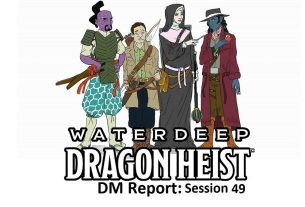“Reaping the Rewards” is a column focusing on finished results of crowdfunding campaigns. Today’s topic is The Daedalus Sentence, a cooperative board game funded in April 2016 by Cripplefish Games and Eagle-Gryphon Games. The game was completed and shipped to backers in October 2016, and is now available online and at game stores.
The Loctae invasion of Earth wiped out most humans, with survivors shipped off for genetic experimentation. You and a few other prisoners are imprisoned in the Hive, a space station filled with labyrinthine passages and dangerous guards. A meteor strike damaged the station’s AI and has released your bonds—this is your chance to escape The Daedalus Sentence.
At a glance: The Daedalus Sentence is a cooperative game for 1 to 5 players, ages 10 and up, and takes about an hour to play. Note that the 5-player version has 4 prisoners working cooperatively against the 5th player, who controls the Hive. While the box says the game takes 45–60 minutes, the game can take longer, particularly if players spend a lot of time debating their moves. The game retails for $149.99.

Components
- Hive Prison board
- 54 Location tiles
- 5 Player boards
- 54 Hive cards
- 1 Theseus board
- 5 Character tokens
- 5 Character figures
- 15 Minotaur figures
- 5 Loctae Scientist figures
- 1 Loctae Hive Commander figure
- 1 Loctae Hive Commander board
- 7 Gate tokens
- 1 Alert marker
- 20 Action tokens
- 3 custom dice (Timer die, Security die, Theseus die)
- 4 Reference boards
Daedalus Sentence has a high price, and when you see the box and the components, it’s easy to see why. The box is huge (and Eagle-Gryphon didn’t skimp on the cardboard there), and it’s filled to the brim with stuff. The cardboard components all punch out very nicely, and the plastic insert is designed to store everything just so (except for the character tokens, which are down in the bottom right corner in one of the extra wells).

There’s a plastic cover that goes on top of this insert, and then the prison board fits upside-down on top of the cover. My only complaint is that the player boards just sit on top of the prison board, and the size is just a little too big to fit them all side by side in the slightly recessed area of the board. It’s not a problem getting the box lid on, but those are the only other thing that don’t have a custom slot.

The miniatures are fun—player characters are colored plastic, and the Loctae (aliens) and Minotaurs (genetic experiments gone wrong) are grey. The optional 5th player character, the Hive Commander, is a Loctae model but in a brown color. I did notice that two of the Minotaur bases were bent a little so they rocked a little.
The Hive cards either show a ring with a number, or a guard—either a Minotaur or Loctae. Each ring shows a value between 1 and 3, and has a color corresponding to one of the rings or a wild color. Also, each ring shows a direction, clockwise or counterclockwise. (The wild colors show four rings alternating between clockwise and counterclockwise.)
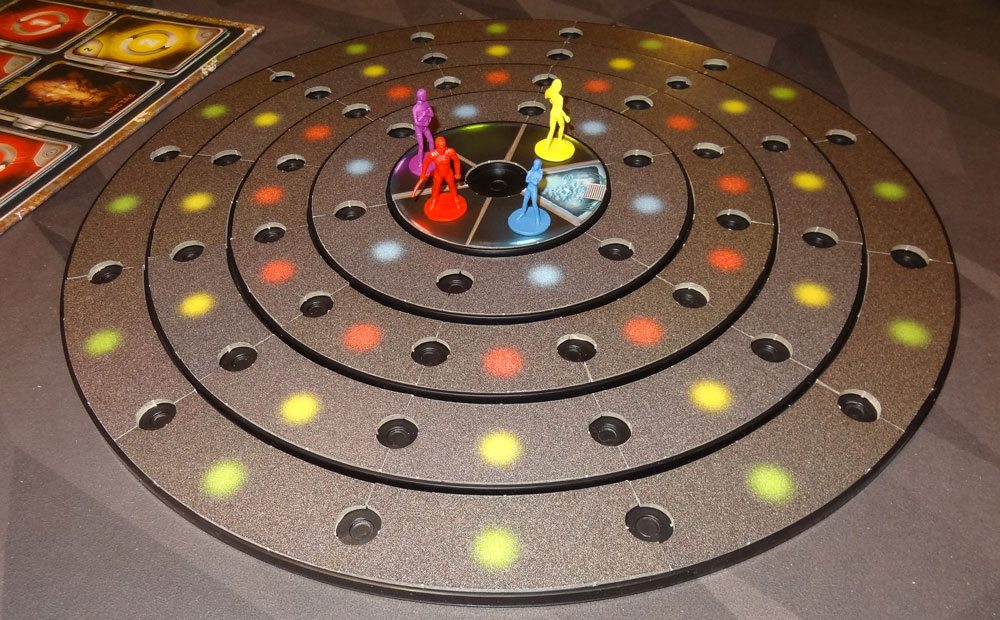
The big highlight of the components, though, is the crazy rotating board. There’s a large round plastic base with five tiers—each one has a slight lip on the outer edge, and some small recessed dots spaced evenly around it. The location tiles fit onto these tiers (they’re color-coded on the backs), with cut out circles that line up with the dots. As you play the game, you’ll flip tiles over to reveal them as you explore, but the rings also rotate at the end of each round. You just put your finger in one of the circles and turn it like a rotary phone (kids, ask your parents). Note that the tiles rotate around on the plastic base—the plastic base itself is one solid piece.
It generally works really well, though when I first assembled the game some of the rings were a little tight trying to get all of the tiles in, so I’d push in the last tile and a tile would pop up elsewhere on the level. Also, if you try to spin the rings too quickly, you can also pop tiles up off the board. I think the tiles have loosened up slightly after playing a few times so the tight fit isn’t such a problem, but you still need to be a little careful when “dialing” the rings around.

The Theseus board holds eight cards, plus character tokens and the alert marker to show what security level the station is on. The board itself is nothing spectacular, but the artwork on it is nice and matches the rest of the components.
Speaking of the artwork: everything has a sort of gritty, industrial look to it: this isn’t your clean white walls sort of sci-fi. I did appreciate that of the five human characters, there are two men and two women (and one who is wearing a weird suit and nobody’s sure of its gender or even if it’s actually human)—plus there’s some ethnic diversity. Even the Hive Commander is referred to as a “she” in the rulebook, though these being aliens I guess I don’t really know what that means specifically.
The custom dice are only used with some of the variant rules, but they’re pretty nice: larger than standard six-sided dice, with the faces engraved and painted. One has various icons on it, and the others just have numbers, which are a little less exciting.
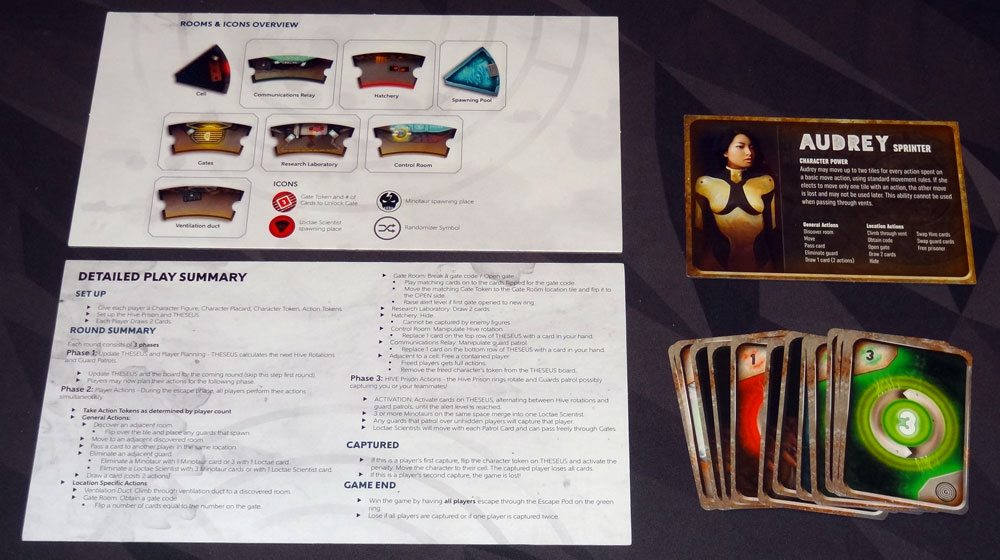
The player boards are double-sided, showing the character’s portrait and name on both sides. One side has the character’s ability, plus a list of all of the actions available to you, so it’s more of a reference sheet than something that is actually used in play. The reverse side of the player board shows the penalty for the team if that character is captured. The reference boards have a more detailed play summary on one side, and the names of all the rooms and icons on the other side. The one thing about the game is that the various locations in the station are basically distinguished by the artwork but don’t have any text or much in the way of gameplay iconography. It might make the game nicer thematically, but I think having more of an indication of what the room does, printed on the room, would be nice. Even the reference board just shows the pictures with the name of the rooms, and you have to flip it over to see what the rooms do—even though it is an enormous piece of cardboard. They’re nice, sturdy cardboard, but both the player board and reference boards could have been designed a little smaller, I think.
How to Play
The rulebook is available to download as a PDF from BoardGameGeek.
The goal of the game is to escape: you must get all of the prisoners from the center cells to the escape pods on the outer ring of the station, and have the right cards to activate them. The players lose if all players are captured by the guards at the same time, or if any character is captured for the second time. (The 5th player variant introduces the Hive Commander, but I’ll explain that later.)
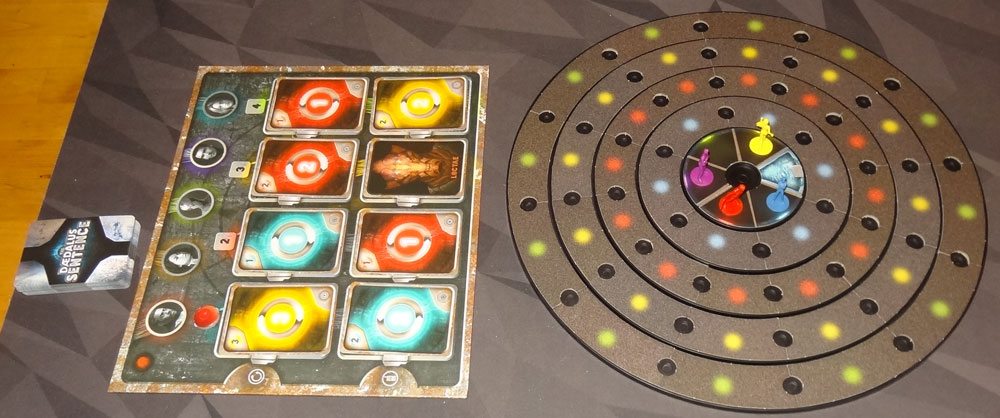
Note: although there are five different prisoner characters, the cooperative mode only goes up to 4 players, so you will never have all five prisoners in play at the same time.
To set up, first shuffle up the location tiles and place them onto the appropriate tiers. The red, yellow, and green tiers have 4 location tiles that have “randomizer” icons on them—you shuffle these, and put 2 into the mix and return the other 2 to the box without looking at them, changing the mix of tiles slightly. On the top tier are the cells and the Loctae spawning chamber—always make sure the purple cell is directly across from the spawning chamber, but the others are randomly placed.
Each player picks a character and takes the character board, and then places the character figure in the corresponding cell. Shuffle the cards, and deal each player two cards. (The hand limit depends on number of players—the more players, the fewer cards each player may hold.) Also give each player action tokens, the little translucent cubes. These are used to keep track of how many actions you have taken—again, the more players there are, the fewer action tokens each player gets.
Place the character tokens for the chosen characters on the Theseus board, with the character side showing. Deal out eight cards for the Theseus board face-up. When filling the board, you should always fill the columns on the board from top to bottom, left to right.
Each round, you update the Theseus board, then the players take actions, and then the Hive is activated—rotating rings and moving guards.
Update Theseus: draw cards and place them on the Theseus board until it is full. Players may plan their actions.
Players Take Actions: This is the bulk of the game, of course. Each player has a limited number of actions, and these may be performed simultaneously or one at a time—players may discuss how to carry out their plans. There are general actions, and location-specific actions, and usually it takes 1 action to do any of these.

General actions:
- Discover a room: flip over an undiscovered tile adjacent to you—tiles in other rings are not adjacent unless there is an open gate connecting them. If there is a Minotaur or Loctae icon on the tile, immediately place a figurine on the location.
- Move: Move to an adjacent tile—it must be discovered, and may not have guards in it. You may not move through walls, or closed gates. You may move through ventilation ducts but only if there is an open gate to that ring already.
- Pass a card: Give a card to another player in the same room.
- Eliminate a guard: Spend matching guard cards to eliminate a guard in an adjacent room (not through ventilation ducts). 3 Minotaurs are equivalent to 1 Loctae—you may spend 3 Minotaur cards to eliminate 1 Loctae, or 1 Loctae card to eliminate up to 3 Minotaurs in the same location. Players may also collaborate to eliminate Loctae by sharing 3 Minotaur cards, but each player that plays cards must use an action.
- Draw card: Spend 2 actions to draw 1 card from the deck.
Location actions:
- Ventilation Duct: Climb through a duct, as long as the room on the other side is discovered, and there is an open gate somewhere into that ring.
- Research Laboratory: You may draw 2 cards instead of 1 when you take the draw cards action.
- Hatchery: Hide! Spend an action, and lay your character on its side. The character is safe from enemies, but comes out of hiding as soon as you take any action. Only one character may hide in the Hatchery at a time.
- Control Room: Manipulate the ring rotation on the Theseus board by swapping a card from your hand with a card on the top row of the board.
- Communications Relay: Manipulate the guard movement on the Theseus board by swapping a card from your hand with a card on the top row of the board.
- Cell: If a player is recaptured and sent back to their cell, you must stand in the room outside the cell and use an action to open the door.
- Gate: Use an action to request the gate code, or spend cards to open the gate. (See below.)
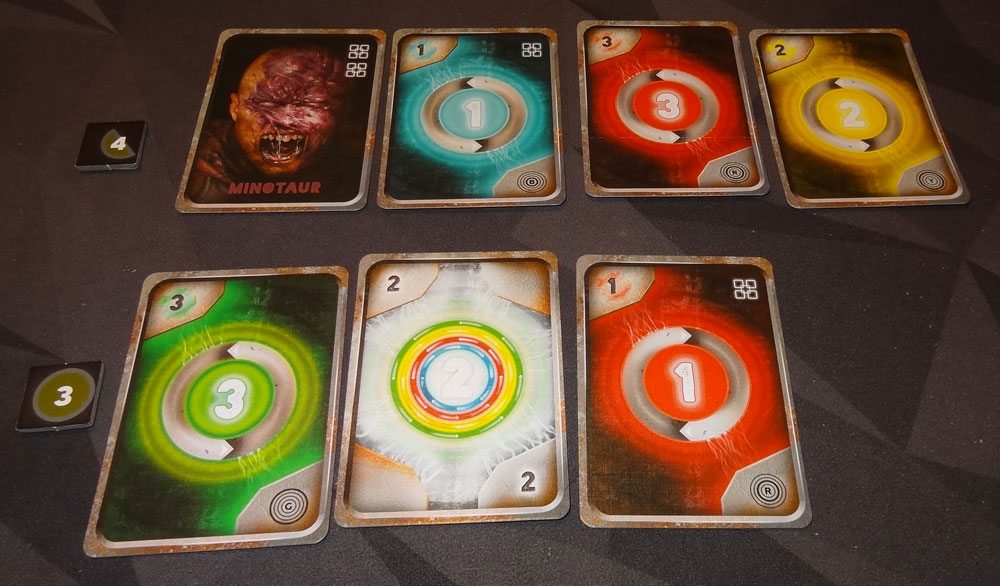
Each gate has a small icon on it showing a colored shape and a number. If you request the code, you draw that number of cards from the deck, setting them aside face-up and placing the corresponding gate token next to those cards. To open the gate, players must contribute cards that match the code all at the same time—you can’t open a gate partially, though multiple players may all contribute cards at the same time.
You must choose to match either all the colors or all the numbers shown on the code (and not a mix of numbers and colors). Wild cards may be matched with any color, and may be used to match any color. Guard cards may be matched with either type of guard card, Minotaur or Loctae. When a gate has been unlocked—each player who contributes cards must be at the gate and spend an action—then the code cards are discarded, and the gate token is placed on the location tile to show that the gate is now open. Every time you gain access to a new ring, the alert level increases (as indicated on the Theseus board).
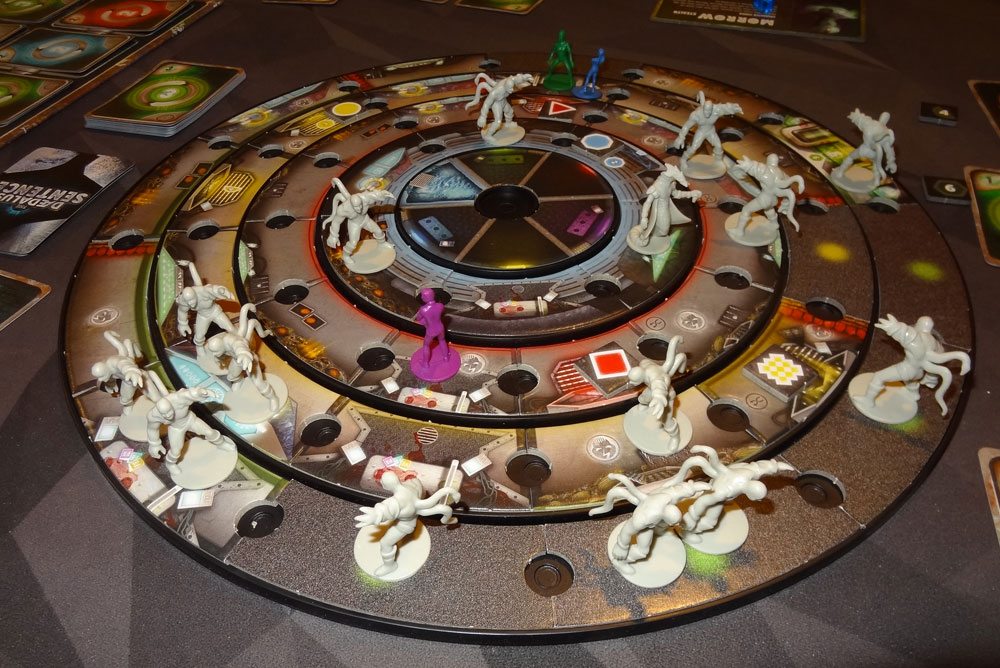
Hive Actions: Once the players have finished their actions (you may leave actions unused if you wish), the Hive activates according to the Theseus board, one column at a time (from 1 to 4). Starting with the left column, you rotate, then move guards.
- Rotate: If the top card in the column is a number card, check the color of the card—that ring will rotate. The card indicates whether it rotates clockwise or counterclockwise, and how many spaces (those recessed dots) to rotate it. Anything on the rings just goes along for the ride. Wild cards will rotate every ring, alternating between clockwise and counterclockwise.
- Move Guards: If the bottom card in the column is a number card, all the guards on the ring matching the card’s color will move the number of spaces and in the direction indicated by the card. Minotaurs always stay on the same ring, but Loctae will go through unlocked doors. (There are some complicated exceptions to this rule, but basically consider that the Loctae are searching for you, and the Minotaurs are mindlessly moving back and forth.) Any guard that encounters a wall will turn around and move in the opposite direction. In the case of a wild card, guards on all rings will move.
If either of the cards is a guard card (Minotaur or Loctae), it means that instead of rotating or moving guards, instead you will spawn a new guard. Flip the next card in the deck to find out where it will spawn: the color of the card indicates which ring Minotaurs will spawn in, in the arc of the ring that corresponds to the matching prisoner cell color. Loctae will always spawn in the Loctae spawning chamber in the center ring. If the card you flip is a Minotaur, then you’ll spawn 2 Minotaurs in the space, and flip another card. If the second card is also a Minotaur, spawn a Loctae instead. Finally, if there are 3 or more Minotaurs in the same location during this phase of the game, you remove them and replace them with a Loctae.
Here’s a video showing the Hive actions during a level 4 alert, so all four columns are activated:
If any guards ever move into the same room as a player, the player is captured and returned to their cell. You must discard all of your cards, and flip your character token over on the Theseus board, as well as your player board. Each player has a specific penalty for being captured:
- Clay Rojas: Spawn an extra Minotaur at the beginning of each Hive phase.
- Audrey Yoo: Control Rooms may not be used to change the Theseus board.
- Jamie Jones: Nobody may move through ventilation ducts.
- Morrow: Communications Relays may not be used to change the Theseus board.
- Elias Fuentes: Research Laboratories may not be used to draw an extra card.

You must wait until another player comes to the entrance to your cell and uses an action to free you, at which point you may immediately take actions, and flip your player board back over. Once you are rescued, discard the character token from the game. If you are captured again, the game is over and the players lose.
Once the Theseus board has finished activating, slide any remaining cards to the left, and then begin a new round.
You win if you get to the escape pods and enter the code. You lose if any character has been captured twice, or if all players are captured at the same time.
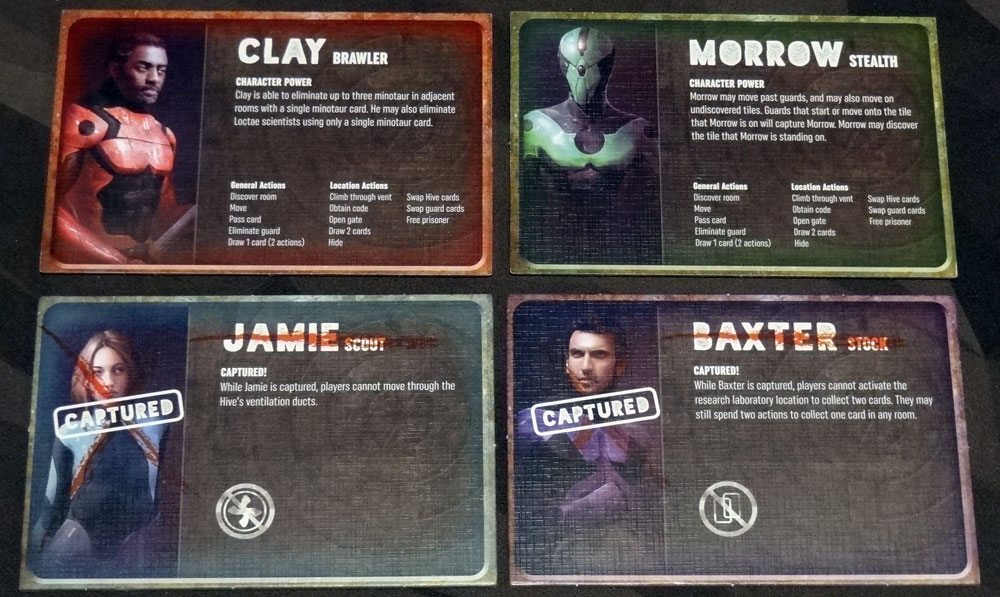
Each character has a special ability:
- Clay Rojas: Can kill up to 3 Minotaurs in adjacent rooms with 1 Minotaur card, or kill a Loctae with a Minotaur card.
- Audrey Yoo: Moves 2 spaces for 1 action (except through vents).
- Jamie Jones: May discover rooms through ventilation ducts, and can enter rings even if no gate has been opened to it yet.
- Morrow: May move past guards and on undiscovered tiles, but will be captured by guards that start on Morrow’s space or move into it.
- Elias Fuentes: Maximum hand size is two larger.
If the game is too easy, you can introduce “Difficulty Enhancers.” I won’t get into all of the details, but there are 7 enhancers for you to mix and match.
- Faulty Algorithm: Cards are placed on the Theseus board face-down, and you roll to see how many are revealed.
- Cloud Disabled: You can’t show your cards to other players.
- Repairs Imminent: Set a 1-hour time limit for the whole game.
- Emergency Protocols: You have a variable limited amount of time to talk and carry out actions—as little as 15 seconds!
- Rolling Lockdowns: The security die indicates a penalty that affects each round.
- Automated Security Systems: You always have 25 seconds to talk and carry out actions.
- Remote Activation Signal: Minotaurs are placed a number of spaces away from their usual spawning points.
Some of these enhancers use the “Data Packet” symbols on the cards to reroll dice, reveal cards, and so on.

Finally, there’s the “Ariadne’s Thread” variant, which adds a fifth player as the Loctae Hive Commander. The Hive Commander starts in the escape pod (revealed) and is trying to get to the spawning chamber, or capture all the prisoners simultaneously. The prisoners must get to the escape pod. Unlike the usual game, players may be captured any number of times, and there are no ongoing penalties for being captured.
The players play almost as before, but you may only draw cards in the Research Laboratory (and only 1 card), cards must be kept secret, and Minotaur cards may be used to eliminate all Minotaurs in a single room. Guard icons no longer spawn guards, but instead let the prisoner draw a card.
You don’t use the guard patrol row of the Theseus board. Instead, the Hive Commander has a hand of cards, and can spend any number of them each turn. Minotaur and Loctae cards may be used to spawn new guards, or to get action points. Numbered cards may be used to rotate a ring of the Hive or gain actions. Actions may be spent to move guards, discover tiles, draw cards, and swap cards with the board. If the Hive Commander is killed, it will respawn in the escape pod the next time a Loctae would spawn.
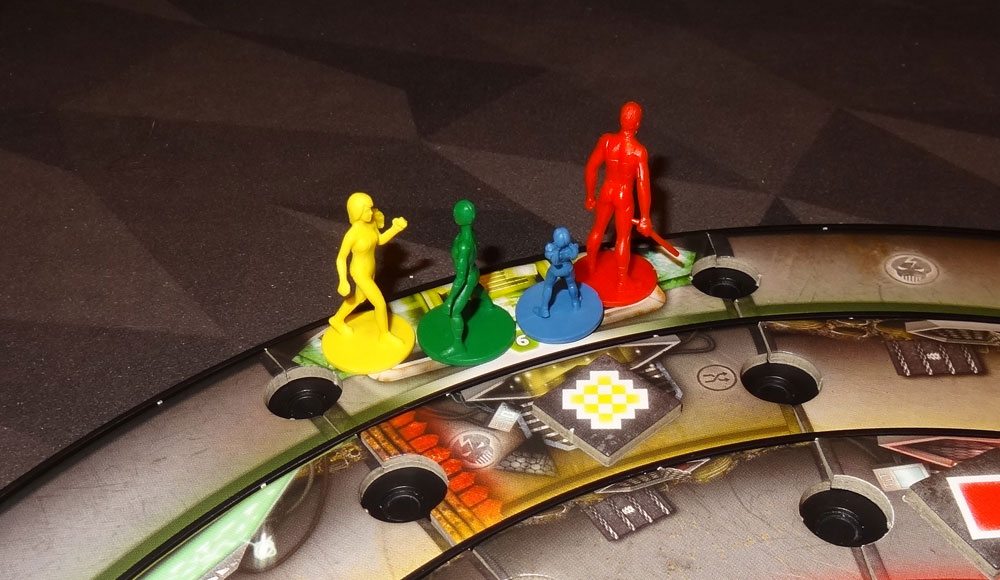
The Verdict
I saw The Daedalus Sentence when it was on Kickstarter and was intrigued by the rotating board, but it was too late at the time to get a prototype to review, so I was glad to get a review copy from Eagle-Gryphon Games so I could see how it all works.
The first thing to address, I think, is the price: at a $149.99 retail, is it worth it? The answer is, as is so often the case: it depends. While the game is fun and has some interesting innovations in the gameplay, it’s clear that the reason the game costs so much is because of the components. That huge plastic disk isn’t cheap, and the box itself probably has as much cardboard as some other entire games. Plus, there’s all of the miniatures, dice, cards, and cardboard tiles. Some of it may be a little overproduced (like those enormous reference boards), but this sort of deluxe treatment is what I’ve come to expect from Eagle-Gryphon.
Any game at this price point is one that you’ll want to play often to get your money’s worth, so then the question becomes: will you want to play this game? Do you have the sort of group that loves playing the same thing many times, or do you like to play something new each time?
But now to the gameplay. The rotating board is something of a gimmick, but it does allow for a very interesting puzzle: as the board shifts and changes, you have to decide how much to risk, and whether you’re in danger of getting caught. I do like the rotating board and the overall mechanics—it does give a good sense of being disoriented in a confusing spaceship and it can lead to some tense moments, which is a good thing in a cooperative game.
The mechanics of the game aren’t too difficult to get, once you have all the pieces, but planning out moves and figuring out what to do next can lead to a bit of analysis paralysis, particularly if you’re trying to be extra careful about finding a safe place to end your turn. The thing about the game, though, is that if you plot out where guards might spawn and take actions carefully, you can usually prevent capture—as long as you’re willing to spend the time to plot everything out. But that does make the game drag, and I have played games that lasted well over an hour because we were so analytical. I think the “Faulty Algorithm” enhancer would be a good option to reduce this sort of analysis, because some of the Theseus cards will be face-down, so you just don’t know for sure what’s coming up and have to take your chances. That, or reducing the amount of time we have to plan and act before forfeiting actions.
As with most cooperative games, it is possible for an alpha player to run the whole game, calling everyone’s shots and making decisions on behalf of other players. Some of the difficulty enhancers (time limits and hidden cards) would go a long way toward solving that issue, though.
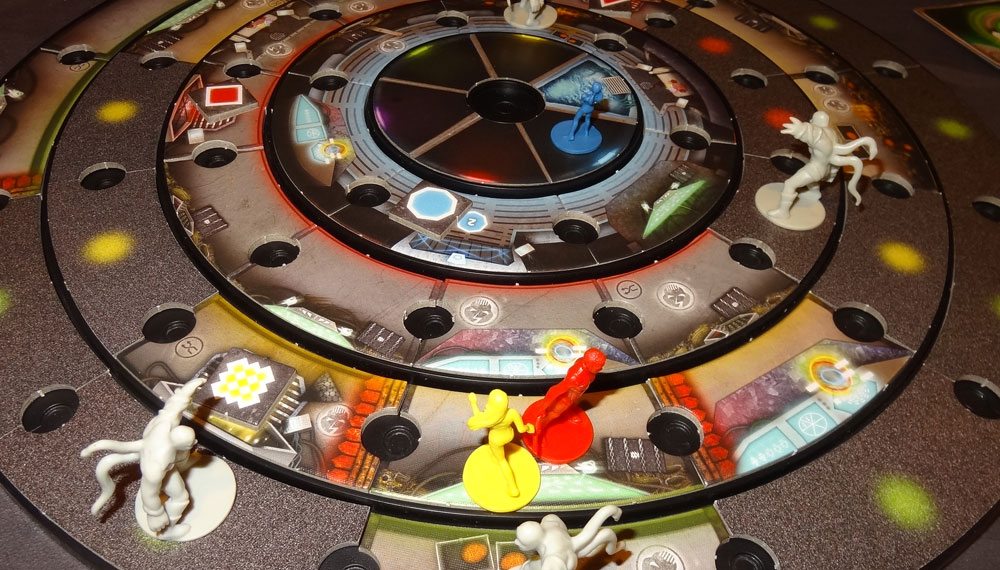
The shifting board can lead to some real predicaments. In my first game, we figured it would be a good idea to open doors as soon as we came to them, trying to get to the outer ring as quickly as possible to look for the escape pod, rather than exploring each ring thoroughly before continuing. That may be a viable strategy sometimes, but it didn’t work out well for us at all. The photo above is a snapshot of one particularly bad moment. Audrey and Clay had explored to the yellow ring, and both of them entered this room through a ventilation duct. Morrow (not pictured) had explored all the way to the green ring, since Morrow can move around on undiscovered tiles. But what Audrey and Clay didn’t know when they stepped into the yellow ring was that both tiles adjacent to them had walls (the thick red markings)—so the room they are in was a dead end. And then the rings rotated, so they lost their exit.
They knew the ring might rotate, but they figured it wasn’t a huge deal, because the red ring has two ventilation ducts and two open gates along it. However, that was before Jamie got captured—and now all the ventilation ducts are sealed and cannot be used. It took several rounds of waiting for the gate to swing back around before they were able to get out—particularly because nobody had access to a Control Room, which would have let us swap out cards on the rotation row of the Theseus board to speed up the process. When we finally did get out, Audrey ran back to save Jamie (because she’s faster) … and got caught herself, because we weren’t paying attention to where the guards might spawn. We did eventually make it off the ship, but learned the importance of scouting carefully.
The other issue with opening gates quickly is that each gate that opens increases the alert level, so there are more rotations and guard movements per round. If you manage to find the escape pod quickly, that could be okay, but Level 4 gets pretty chaotic. There’s even one gate on the yellow ring with a 0-card code, so as soon as you discover it, the alert level jumps to 4 because the gate is already open. That can be a nasty surprise when you’re not ready for it.
I think your enjoyment of the game can be heavily dependent on whether you find the Hive phase interesting or tedious. Personally, I really liked the logistics puzzle of figuring out how to swap the right cards to move doors and ducts into the right places, and I think the rotating board is a neat trick. Plus, it feels to me that while many tabletop games could be simulated much more easily digitally, there’s something fun about pushing cardboard and physical bits around. (See also: Star Wars X-Wings Miniatures.) If you don’t like complicated processes, that cuts out a lot of excellent tabletop games. That said, some of the folks I’ve played The Daedalus Sentence with didn’t feel there was enough to keep them coming back.
In the end, I know The Daedalus Sentence is going to be a tough sell: it costs a lot more than many games, and isn’t necessarily the best cooperative game I’ve played. However, it is unique and presents some interesting gameplay that you can’t quite find anywhere else, so if you like unusual mechanics and components, you might find it a good fit for you and your gaming group.
Disclosure: GeekDad received a review copy of this game.



